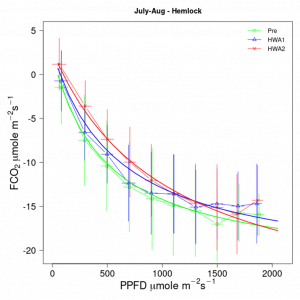What happens when the dominant tree species in a forest is killed off by an insect pest? Eastern hemlock (Tsuga canadensis) is considered a foundation species with a range spanning eastern North America from the southern Appalachians to southern Canada. Hemlock stands create positive ecological feedbacks that promote hemlock dominance and form a unique habitat with an open, cool and shady understory, and a thick organic soil layer. However, an imported insect pest, the hemlock woolly adelgid (HWA) arrived in the 1950s and has been steadily expanding throughout the hemlock’s range. Once a stand is infested, most hemlocks inevitably die over a 5-15 year period as the HWA feeds on their sap and weakens them. Most eastern hemlock stands in the southern Appalachians have already been wiped out by HWA. Cold temperatures during winter have been limiting the northward spread of HWA, but as winter temperatures have become warmer, the adelgids have been spreading northward. HWA in southern New England was first detected in 1985, and then spread throughout most hemlock stands in Connecticut over the next 20 years.
As HWA marched through the lower Connecticut River Valley, researchers at the Harvard Forest established forest plots to monitor vegetation dynamics over time. In New England, hemlocks are most commonly replaced by black birch. These studies provide detailed understanding of growth, mortality, vegetation dynamics, biomass, and soil characteristics at the stand level over multi-year intervals (Ellison et al., 2018). Such a dramatic shift from mature evergreen trees to a dense stand of rapidly growing deciduous seedlings will sharply alter the magnitude and timing of carbon and water exchange, modify the microclimate, and potentially release carbon that has been stored in thick organic soil layers. Carbon loss from the soils and woody debris (dead trees and roots) may be offset by carbon uptake as the new birch stand emerges.

Left panel shows a typical healthy hemlock stand in July 2010 with open subcanopy and very sparse ground vegetation. Right panel shows a nearby location where hemlocks are dead or dying and black birch saplings have established in the gaps formed by thinning of the hemlock crowns.
With the expectation that HWA would eventually reach Harvard Forest itself, we set up a second flux tower (US-Ha2) in an intact hemlock stand to complement the existing flux tower in an oak-maple dominated stand (US-Ha1). Initial observations from the tower focused on short-term physiological measurements until the tower was fully instrumented for eddy covariance measurements in 2004.
HWA was first detected at Harvard Forest in 2009 and started to cause substantial stress in 2012. The long-term continuous flux measurements from 2004 to 2009 provide an essential baseline to define CO2, H2O, energy, and momentum fluxes in a healthy hemlock stand and their functional response to environmental conditions. An array of environmental sensors near the tower is tracking the microclimate. Since 2010 to the present, repeated tree surveys of inventory plots and canopy mapping by lidar is showing that the canopy is thinning, hundreds of hemlocks of all size classes have died, and black birch seedlings are sprouting in the canopy gaps.
The CO2 flux observations are showing a noticeable decline in photosynthetic capacity that is illustrated by shifts in photosynthetic light curves. Net CO2 uptake for a given light level has progressively declined over the course of infestation so far. The reduction in net CO2 uptake is most pronounced at moderate light intensities. At the highest light levels when photosynthesis is saturated, the net fluxes have been comparable over time. A set of automated soil respiration chambers in the heavily infected stand and in a nearby less impacted stand is collecting data on changes in respiration that will help to understand belowground processes. Analyses are ongoing to quantify changes in evapotranspiration. We expect both the magnitude and seasonal timing of water fluxes to be affected by the transition from evergreen to deciduous trees and change in forest structure that initially exposes the soil surface to more sunlight and higher temperatures. In addition, a gaged stream that drains the hemlock dominated watershed near the flux tower since 2005 will document changes in water yield and timing over the course of HWA infestation. This array of measurements from below ground to the top of the canopy and across the watershed will provide detailed insights on how carbon, water, and energy exchanges at ecosystem scale respond on time scales from hours to decades to the loss of a foundation species.

Average CO2 fluxes over 200 mmole m-2 s-1 increments in PPFD (photosynthetic photon flux density) for the years 2004-2009 (pre),2010-2015 (HWA1), and 2016-2021 (HWA2), which represent pre-infestation, and 2 periods after HWA was detected near the flux tower. Vertical segments are standard deviations around the mean. Lines without symbols are the predicted CO2 fluxes for a non-linear fit to the observations over the three intervals. Over time the magnitudes of observed CO2 fluxes for a given light level decline.
Author affiliations
William Munger1, David Orwig2,Jackie Matthes2
1 Harvard University, School of Engineering and Applied Sciences
2 Harvard University, Harvard Forest
Citations
Ellison, A.M., D.A. Orwig, M.C. Fitzpatrick, and E.L. Preisser. 2018. The past, present, and future of the hemlock woolly adelgid (Adelges tsugae) and its ecological interactions with eastern hemlock (Tsuga canadensis) forests. Insects 9, 172; https://doi.org/10.3390/insects9040172

No Comments
Be the first to start a conversation